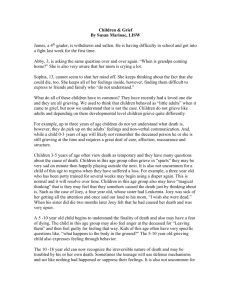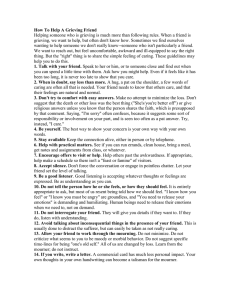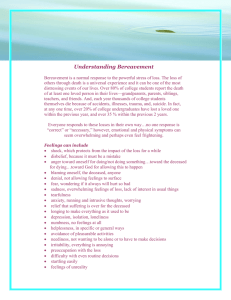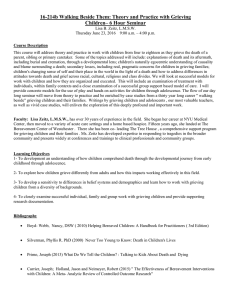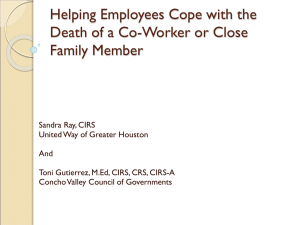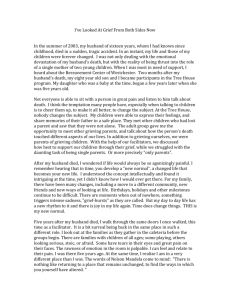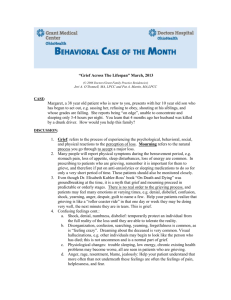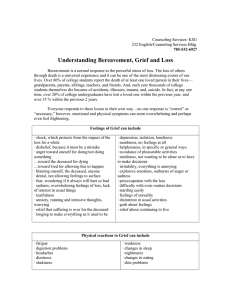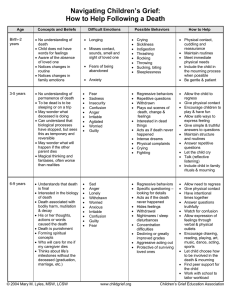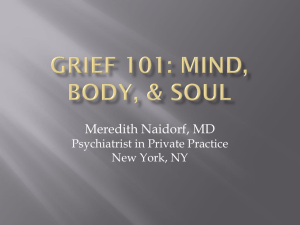Chapter 8 overview
advertisement
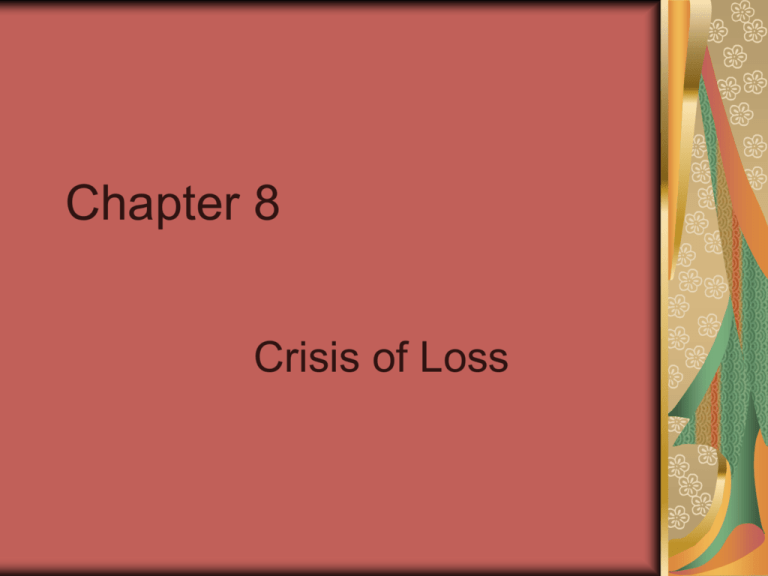
Chapter 8 Crisis of Loss Loss By Rita Moran PLEASE, don't ask me if I'm over it yet. I'll never be over it. PLEASE, don't tell me she's in a better place. She isn't here with me. PLEASE, don't say at least she isn't suffering. I haven't come to terms with why she had to suffer at all. PLEASE, don't tell me you know how I feel. Unless you have lost a child. PLEASE, don't ask me if I feel better. Bereavement isn't a condition that clears up. PLEASE, don't tell me at least you had her for so many years. What year would you choose for your child to die? PLEASE, don't tell me God Never gives us more than we can bear. PLEASE, just say you are sorry. PLEASE, just say you remember my child, if you do. PLEASE, just let me talk about my child. PLEASE, mention my child's name. PLEASE, just let me cry. Types of Loss A. The death of a spouse is one of the most emotionally stressful and disruptive events in life. Many other problems are faced such as economic, career, and family etc.. B. Every parent suffers the loss of a child somewhat differently. And it is traumatic for parents of children of all ages. There is no pattern that your mind can connect the death of a child to so one adjusts their thinking. The bond to that child is forever. C. The loss of a loved one by suicide is doubly stressful. The victim of suicide is often the ones left behind, and can be more vulnerable to physical and mental health problems than are grievers from other causes of death. Support groups have been recommended to help people cope with loss following a suicide. D. Children who experience the death of a parent or sibling may show overt signs of bereavement, but some may be covert. Preschool and school aged children show different signs of grief. Older children show more anxiety, depression, and somatic symptoms, while younger children exhibitsadness, anger, crying, feelings of remorse and guilt, and separation anxiety. E. Children’s cognitive, affective, and behavioral responses must be approached not in terms of adult perspectives but in terms of each child’s understanding and developmental stage. They can misinterpret the event and lack the grieving process. They need to hear over and over again that they are safe and someone needs to listen to their feelings. Honesty about the loss should be shared and they should be allowed to grieve at their own level. F. Adolescence who are in bereavement need to be included in the family’s grief, while at the same time need privacy. They need opportunities to be included in discussions, planning, mourning, and funeral and commemorative activities. Teenagers may benefit from counseling as long as three years following the sibling death. Do not put a time limit on the grieving process. G. Divorce can place children in untenable positions, causing them to feel confused, insecure, fearful, trapped, angry, unloved and guilty. It is a loss. H. Elderly people generally experience more losses than do their younger counterparts. The most devastating is the loss of a spouse. They respond in three ways (1) they totally ignore death, (2) excessive thoughts about dying, (3) a healthy balance. Allowing them to share their past will help an elderly persons selfesteem. Stages and Tasks of Mourning Kubler-Ross’s 5 Stages of Death and Dying: 1. 2. 3. 4. 5. Denial and shock Anger Bargaining Depression Acceptance Worden’s 4 Tasks of Mourning: 1. 2. 3. 4. Acceptance that the death is real. Grieving the loss, expressing feelings about loss. Adjusting to life without the deceased party. Withdrawing energy from the lost person and re-investing in someone or something else. The Schneider model deals with eightstages of grieving. It is a growth-promoting model designed to nurture as much personal growth as possible within a context of stress, loss, and grief. It includes internal events, systems of belief, and the processes of growth and aging as well as the easily recognized losses, such as death and divorce. The stages are as follows: 1. Initial Awareness-shock, confusion, numbness, detachment, disbelief, and disorientation 2. Attempts at Limiting Awareness by Holding On-using coping mechanisms to stave off immobility and disequilibrium 3. Attempts of Limiting Awareness by Letting Go-recognizing one’s personal limits with regard to the loss 4. Awareness of the Extent of the Loss-most painful, lonely, helpless, and hopeless phase 5. Gaining Perspective on the Lossreaching a point of accepting that what is done is done and providing the bereaved people with a time to make peace with their past 6. Resolving the Lost-when they can see and pursue activities unconnected with the loss without it being a reaction against or identifying with the lost person or object 7. Reformulating Loss in a Context of growth-discovering potential rather than limits, seeing problems as challenges, being curious again, and seeking a balance between the different aspects of self 8. Transforming Loss into New Levels of Attachment-approach life with greater openness and the willingness to surrender more readily the necessity of structure in life, reformulation that produces a greater capacity for growth than before Interventions Help talk about the loss, don’t be afraid to ask what happened. Help identify and express feelings Help live without the deceased or lost loved object. Problem solving works Facilitate emotional withdrawal from deceased. Encourage to move on Provide time to grieve actively. Prepare for holidays and anniversaries Educate about customary grieving reactions of others Allow for individual differences Provide for continuing support. Groups are great! Divorce and Separation About 50% of marriages end in divorce. Each partner must complete tasks of mourning Children need not suffer if parents manage feelings appropriately Rage and frustration are common Custody arrangements are complicated Other issues Financial loss Social loss Family loss At risk for increase substance use Feelings of guilt and resentment Interventions Referrals to support groups, 12 step groups and the use of church, school and athletic organizations, as are books. Help clients grieve: they need to cry a lot, write, read, pray and talk. Be optimistic, the pain will end eventually, support how difficult it is. Children and Divorce 26% of children under the age of 18 live with a divorced parent. 39% of divorced women with children live in poverty Civility among parents and assurance that both still love the children is helpful Some need brief individual play therapy, others need family counseling Blended family issues Loyalty is a problem May feel guilty for bonding with a step parent Children often act out, won’t even try to like a step parent. Family must incorporate new parent’s style and rules.
